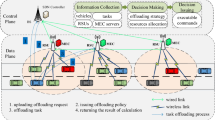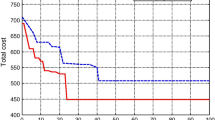Abstract
Mobile edge computing (MEC) is a promising technology for the Internet of Vehicles, especially in terms of application offloading and resource allocation. Most existing offloading schemes are sub-optimal, since these offloading strategies consider an application as a whole. In comparison, in this paper we propose an application-centric framework and build a finer-grained offloading scheme based on application partitioning. In our framework, each application is modelled as a directed acyclic graph, where each node represents a subtask and each edge represents the data flow dependency between a pair of subtasks. Both vehicles and MEC server within the communication range can be used as candidate offloading nodes. Then, the offloading involves assigning these computing nodes to subtasks. In addition, the proposed offloading scheme deal with the delay constraint of each subtask. The experimental evaluation show that, compared to existing non-partitioning offloading schemes, this proposed one effectively improves the performance of the application in terms of execution time and throughput.
Similar content being viewed by others
References
Ma X, Zhao Y, Zhang L, Wang H, Peng L. When mobile terminals meet the cloud: computation offloading as the bridge. IEEE Network, 2013, 27(5): 28–33
Chen B, Wu L, Wang H, Zhou L, He D. A blockchain-based searchable public-key encryption with forward and backward privacy for cloud-assisted vehicular social networks. IEEE Transactions on Vehicular Technology, 2020, 69(6): 5813–5825
Elazhary H, Aloraini S, Aljuraid R. Context-aware mobile application task offloading to the cloud. International Journal of Advanced Computer Science & Applications, 2017, 8(5): 381–390
Marotta M A, Faganello L R, Schimuneck M A K, Granville L Z. Managing mobile cloud computing considering objective and subjective perspectives. Computer Networks, 2015, 93(P3): 531–542
Guo S, Liu J, Yang Y, Xiao B, Li Z. Energy-efficient dynamic computation offloading and cooperative task scheduling in mobile cloud computing. IEEE Transactions on Mobile Computing, 2019, 18(2): 319–333
Yi S, Li C, Li Q. A survey of fog computing: concepts, applications, and issues. In: Proceedings of the 2015 Workshop on Mobile Big Data (Mobidata ′15). 2015, 1–6
Zeng D, Gu L, Pan S, Cai J, Guo S. Resource management at the network edge: A deep reinforcement learning approach. IEEE Network, 2019, 33(3): 26–33
Jararweh Y, Doulat A, Darabseh A, Alsmirat M, Benkhelifa E. Sdmec: Software defined system for mobile edge computing. In: Proceedings of IEEE International Conference on Cloud Engineering Workshop. 2016, 88–93
Hu Y C, Patel M, Sabella D, Sprecher N, Young V. Mobile edge computing-a key technology towards 5G. ETSI white paper, 2015, 11(11): 1–16
Gu L, Cai J, Zeng D, Zhang Y, Jin H, Dai W. Energy efficient task allocation and energy scheduling in green energy powered edge computing. Future Generation Computer Systems, 2019, 95(JUN.): 89–99
Chen B, Wu L, Li L, Choo K K R, He D. A parallel and forward private searchable public-key encryption for cloud-based data sharing. IEEE Access, 2020, 8(99): 28009–28020
Satria D, Park D, Jo M. Recovery for overloaded mobile edge computing. Future Generation Computer Systems, 2017, 70: 138–147
Patel M, Naughton B, Chan C, Sprecher N, Abeta S, Neal A. Mobile-edge computing introductory technical white paper. White paper, Mobile-Edge Computing (MEC) Industry Initiative, 2014, 29: 1089–7801
Wang J, Wu L, Choo K K R, He D. Blockchain-based anonymous authentication with key management for smart grid edge computing infrastructure. IEEE Transactions on Industrial Informatics, 2020, 16(3): 1984–1992
Chaudhary R, Kumar N, Zeadally S. Network service chaining in fog and cloud computing for the 5G environment: data management and security challenges. IEEE Communications Magazine, 2017, 55(11): 114–122
Tong L, Li Y, Gao W. A hierarchical edge cloud architecture for mobile computing. In: Proceedings of the 35th Annual IEEE International Conference on Computer Communications. 2016, 1–9
Sun Y, Zhou S, Xu J. Emm: Energy-aware mobility management for mobile edge computing in ultra dense networks. IEEE Journal on Selected Areas in Communications, 2017, 35(11): 2637–2646
Xiao Y, Krunz M. Qoe and power efficiency tradeoff for fog computing networks with fog node cooperation. In: Proceedings of IEEE Conference on Computer Communications. 2017, 1–9
Khan M A. A survey of computation offloading strategies for performance improvement of applications running on mobile devices. Journal of Network and Computer Applications, 2015, 56: 28–40
Hassan M A, Xiao M, Wei Q, Chen S. Help your mobile applications with fog computing. In: Proceedings of IEEE International Conference on Sensing, Communication and Networking Workshops. 2015, 1–6
Takahashi N, Tanaka H, Kawamura R. Analysis of process assignment in multi-tier mobile cloud computing and application to edge accelerated Web browsing. In: Proceedings of IEEE International Conference on Mobile Cloud Computing, Services and Engineering. 2015, 233–235
Chen X, Jiao L, Li W, Fu X. Efficient multi-user computation offloading for mobile-edge cloud computing. IEEE/ACM Transactions on Networking, 2016, 24(5): 2795–2808
Zhang K, Mao Y, Leng S, Vinel A, Zhang Y. Delay constrained offloading for mobile edge computing in cloud-enabled vehicular networks. In: Proceedings of International Workshop on Resilient Networks Design & Modeling. 2016, 288–294
Beck M T, Feld S, Fichtner A, Linnhoff-Popien C, Schimper T. Mevolte: Network functions for energy-efficient video transcoding at the mobile edge. In: Proceedings of the 18th International Conference on Intelligence in Next Generation Networks. 2015, 38–44
Jalali F, Hinton K, Ayre R, Alpcan T, Tucker R S. Fog computing may help to save energy in cloud computing. IEEE Journal on Selected Areas in Communications, 2016, 34(5): 1728–1739
Dai Y, Xu D, Maharjan S, Zhang Y. Joint load balancing and offloading in vehicular edge computing and networks. IEEE Internet of Things Journal, 2019, 6(3): 4377–4387
Raza S, Liu W, Ahmed M, Anwar M R, Wang S. An efficient task offloading scheme in vehicular edge computing. Journal of Cloud Computing Advances Systems and Applications, 2020, 9(1): 1–14
Guo H, Zhang J, Liu J. Fiwi-enhanced vehicular edge computing networks: Collaborative task offloading. IEEE Vehicular Technology Magazine, 2019, 14(1): 45–53
Huang X, Xu K, Lai C, Chen Q, Zhang J. Energy-efficient offloading decision-making for mobile edge computing in vehicular networks. EURASIP Journal on Wireless Communications and Networking, 2020, 2020(1): 1–16
Du J, Yu F R, Chu X, Feng J, Lu G. Computation offloading and resource allocation in vehicular networks based on dual-side cost minimization. IEEE Transactions on Vehicular Technology, 2019, 68(2): 1079–1092
Zhang K, Mao Y, Leng S, He Y, Zhang Y. Mobile-edge computing for vehicular networks: A promising network paradigm with predictive offloading. IEEE Vehicular Technology Magazine, 2017, 12(2): 36–44
Chen X, Shi Q, Yang L, Xu J. Thriftyedge: Resource-efficient edge computing for intelligent iot applications. IEEE Network, 2018, 32(1): 61–65
Li H, Ota K, Dong M. Learning iot in edge: Deep learning for the internet of things with edge computing. IEEE Network, 2018, 32(1): 96–101
Tobita T, Kasahara H. A standard task graph set for fair evaluation of multiprocessor scheduling algorithms. Journal of Scheduling, 2010, 5(5): 379–394
Yang L, Cao J, Yuan Y, Li T, Han A, Chan A. A framework for partitioning and execution of data stream applications in mobile cloud computing. ACM SIGMETRICS Performance Evaluation Review, 2013, 40(4): 23–32
Liu Y, Yu H, Xie S, Zhang Y. Deep reinforcement learning for offloading and resource allocation in vehicle edge computing and networks. IEEE Transactions on Vehicular Technology, 2019, 68(11): 11158–11168
Acknowledgements
This work was supported by the National Natural Science Foundation of China (Grant Nos. U20A20177, 61772377, 91746206), the Fundamental Research Funds for the Central Universities, and Science and Technology planning project of ShenZhen (JCYJ20170818112550194).
Author information
Authors and Affiliations
Corresponding authors
Additional information
Libing Wu received his PhD degree in Computer Science from Wuhan University, China. Now he is a Professor in School of Cyber Science and Engineering and School of Computer Science, and Shenzhen Research Institute of Wuhan University, China. His current research interests include network communication, grid computing and Internet of Things.
Rui Zhang received her Master degree in computer application technology from Nanchang Hangkong University, China. She is studying in the School of Computer Science, Wuhan University, China. Her current research interests include Internet of Vehicles, Artificial Intelligence and Edge Computing.
Qingan Li received the BS and PhD degrees in computer science from Wuhan University, China in 2008 and 2013 respectively. He also received the PhD degree in computer science from City University of Hong Kong, China, in 2014. He is currently an associate professor in the School of Computer Science at Wuhan University, China. His current research interests include software optimization and embedded systems.
Chao Ma (member of IEEE and professional member of CCF) received the BE degree in computer science and PhD degree in software theory from Wuhan University, China in 2005 and 2010, respectively. He is currently an Assistant Professor of School of Cyber Science and Engineering at Wuhan University, China. His research interests include time series analytics, representation learning, program comprehension, knowledge graph and generative adversarial networks.
Xiaochuan Shi received the BS degree in Computer Science and Techology from Wuhan University, China in 2006 and the MS degree in Software Theory from Wuhan University, China, in 2008. He received the PhD degree in computer architecture from Wuhan University, China in 2011. He is currently an Associate Professor with the School of Cyber Science and Engineering, Wuhan University, China. His research interests include Big data analysis, reinforcement learning, data modeling, wireless sensor networks.
Rights and permissions
About this article
Cite this article
Wu, L., Zhang, R., Li, Q. et al. A mobile edge computing-based applications execution framework for Internet of Vehicles. Front. Comput. Sci. 16, 165506 (2022). https://doi.org/10.1007/s11704-021-0425-6
Received:
Accepted:
Published:
DOI: https://doi.org/10.1007/s11704-021-0425-6




